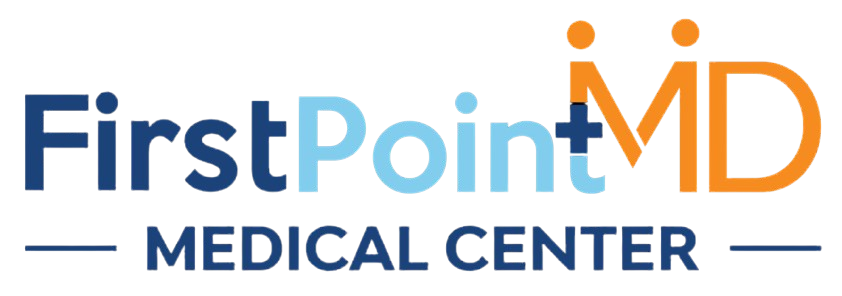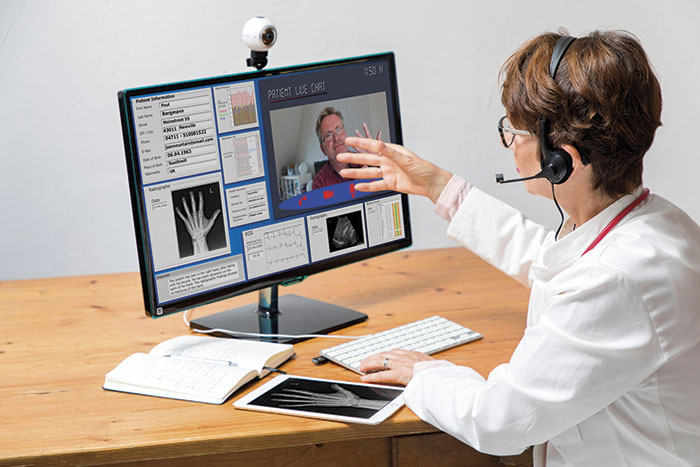At First Point MD, we constantly evaluate cutting-edge health care delivery methods to ensure our patients receive the best outcomes. Telemedicine has emerged as a major innovation, especially in managing chronic conditions like diabetes. In this article, we explore the evidence for telemedicine’s effectiveness in diabetes management, its strengths and limitations, and what patients should expect if they use telemedicine for their care.
What Telemedicine Means for Diabetes Care
Telemedicine refers to delivering medical services remotely using technology—video calls, phone calls, secure messaging, remote monitoring devices, mobile apps, and sometimes wearable sensors. For diabetes, telemedicine can encompass:
-
Remote consultations with endocrinologists, primary care physicians, diabetes educators
-
Remote monitoring of blood glucose (via continuous glucose monitors, glucometers that send data online)
-
Digital self-management tools: educational modules, reminders, dietary and exercise coaching
-
Medication management and adjustments based on remote data
-
Support for behavioral change, lifestyle, diet, exercise through virtual coaching
It can also be synchronous (real-time video) or asynchronous (messages or data that are reviewed later).
Evidence: How Effective Is Telemedicine for Diabetes?
A growing body of research shows that telemedicine can be effective in improving glucose control, adherence, and patient satisfaction. The level of impact depends on the type of intervention, patient population, duration, and how well telemedicine is integrated into overall care.
Here are key findings from recent studies:
-
Improved Glycemic Control (HbA1c Reduction)
-
A systematic review and meta-analysis (2025) including randomized controlled trials (RCTs) with nearly 4,000 patients found that telehealth significantly improves blood glucose management quantified by HbA1c, with a standard mean difference (SMD) around 0.20 (roughly speaking, a modest but clinically meaningful reduction) compared to standard in-person care.
-
Remote monitoring combined with feedback from providers often produces better improvements than remote monitoring alone.
-
For patients with uncontrolled or high baseline HbA1c, the benefit tends to be larger.
-
-
Comparable Outcomes in Some Underserved or Urban Areas
-
For marginalized populations or urban medically-underserved areas, telemedicine shows outcomes similar to face-to-face visits in lowering HbA1c. For example, a study of type-2 diabetes patients in urban underserved populations showed that telemedicine users had approximately 0.34% lower HbA1c than those using traditional care.
-
-
Cost, Access, and Patient Satisfaction Benefits
-
Patients save time and travel costs. Studies in veterans and rural populations showed high appointment adherence rates and strong satisfaction with telemedicine models.
-
In many settings, telemedicine improves access to specialists or diabetes education that may otherwise be challenging to reach.
-
-
Behavioral Outcomes, Self-Management, and Lifestyle Change
-
Telemedicine interventions that include education, feedback, and monitoring often increase patient self-efficacy, improve medication adherence, and encourage health behavior changes in diet and physical activity.
-
Virtual or remote feedback helps patients correct trends before they worsen.
-
-
Limitations & Mixed Results
-
Some studies show smaller or non-significant differences, especially in patients with complex comorbidities or in cases where the telemedicine intervention is minimal (e.g. occasional phone calls only).
-
Digital access, technology literacy, reliable internet connection, patient engagement all affect effectiveness.
-
What Patients Should Expect When Using Telemedicine for Diabetes
When you choose telemedicine as part of your diabetes management plan, here is what you should expect to ensure the best outcomes:
| Aspect | Best Practices / Typical Features | Why They Matter |
|---|---|---|
| Initial Setup & Technical Onboarding | Your provider will ensure you have needed devices (glucometer that connects, CGM or continuous sensor if needed), instructions on how to transmit data, how to use the tele-platform securely. | Smooth setup avoids delays or confusion, ensures data is reliable. |
| Regular Remote Monitoring | Frequent or periodic data uploads (blood glucose, sometimes blood pressure or weight), possibly continuous glucose monitoring (CGM) or flash glucose monitoring. | Allows providers to detect trends and intervene early. |
| Scheduled Virtual Visits + Check-Ins | Video or phone appointments at regular intervals (often monthly or quarterly), plus possible asynchronous check-ins or messaging in between. | Maintains accountability, lets you ask questions, updates therapy. |
| Feedback & Adjustment of Treatment | If glucose is trending high or low, medication dosages, lifestyle recommendations may be adjusted remotely; patients may be coached on diet/exercise. | Tailored work keeps control tight. |
| Education and Self-Management Support | Access to diabetes education (nutrition, carbohydrate counting, insulin technique), behavioral coaching, reminders, goal setting. | Empowering patients improves adherence and long-term outcomes. |
| In-Person Visits When Necessary | Foot exams, retinal screening, laboratory tests, physical examinations still happen physically. Annual or semi-annual in-person checkups are usually needed. | Some assessments cannot be done remotely; safety requires periodic in-person contact. |
| Privacy, Data Security, Ease of Use | Secure telehealth platform, encryption, easy interface (especially for older adults), help with navigation. | If the technology is difficult, data incomplete or patients drop off. |
| Support for Access Barriers | Assistance when patients lack devices, have poor internet, or low tech literacy. | Otherwise telemedicine risks widening disparities. |
Which Patients Gain the Most (and Who Might Need Hybrid or Traditional Models)
Telemedicine does well—but it is not a one-size-fits-all solution. Patients are likely to benefit more when they:
-
Have type 2 diabetes, particularly when lifestyle modification plays a big role.
-
Are engaged and willing to self-monitor, use devices/technology.
-
Have relatively stable disease, not many urgent complications or comorbid conditions.
-
Live in rural or underserved areas where in-person care is difficult.
Patients who may need more in-person care or hybrid models include:
-
Those with type 1 diabetes who require frequent insulin adjustments, complicated insulin regimens, or have frequent hypoglycemia.
-
Patients with advanced complications (diabetic foot ulcers, retinopathy, cardiovascular disease) needing physical exams.
-
Those without reliable access to technology or internet.
-
Individuals uncomfortable or inexperienced with digital platforms.
How Telemedicine Is Implemented in Practice at First Point MD
At First Point MD, we believe in integrating telemedicine thoughtfully into a comprehensive diabetes care program. Our approach includes:
-
Providing patients with remote monitoring tools (glucometers / CGMs) and training on use.
-
Regularly scheduled virtual follow-ups plus asynchronous check-ins via secure messaging.
-
Access to diabetes educators, nutritionists, and health coaches virtually.
-
Using data dashboards to track trends, flag problems early.
-
Ensuring in-person care — labs, foot exams, retinal screening — are scheduled annually or as needed.
-
Supporting patients with less tech experience — helping them with devices, internet access support, simplifying platforms.
Clinical Outcomes & What Results to Anticipate
If telemedicine is done well, patients might reasonably expect:
-
A reduction in HbA1c of perhaps 0.3–1.0% depending on how high baseline HbA1c is and how intensive the remote interventions are.
-
More consistent medication adherence.
-
Better glucose stability (fewer severe highs and lows).
-
Increased patient satisfaction and convenience (fewer missed appointments, decreased travel burden).
-
Enhanced ability to detect and address early signs of complications.
Potential Challenges and How to Overcome Them
| Challenge | Mitigation Strategies |
|---|---|
| Technology Access & Digital Literacy | Provide training; use simple tools; loan devices; ensure mobile-friendly platforms. |
| Patient Engagement Over Time | Use frequent feedback; set reminders; involve family/caregivers; use motivational strategies. |
| Data Overload for Providers | Use dashboards, automated alerts, triage systems; allocate staff support. |
| Privacy and Security Concerns | Use HIPAA (or relevant local)-compliant platforms; clear consent; educate patients on security. |
| Reimbursement / Insurance Coverage | Work with insurers; verify which telemedicine services are covered; counsel patients. |
| Need for Physical Exams / Diagnostics | Plan hybrid care; schedule periodic in-person visits for exams, labs. |
Summary: Is Telemedicine Effective?
Yes — telemedicine is an effective tool for many patients with diabetes. When carefully implemented, it can improve glycemic control, increase accessibility, reduce costs, and enhance patient satisfaction. It works best when combined with remote monitoring, good patient support, education, and periodic in-person care for physical examinations that cannot be done virtually.
However, each patient should understand the expectations, limitations, and commitment involved—especially around adherence, technology use, and maintaining regular follow-ups.
At First Point MD, we are committed to offering telemedicine as part of a patient-centered, evidence-based diabetes management program, designed to deliver the best outcomes while honoring each individual’s needs and circumstances.


